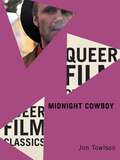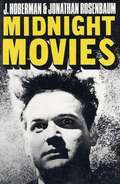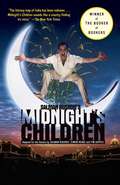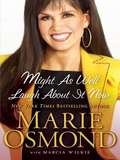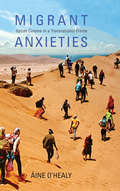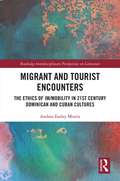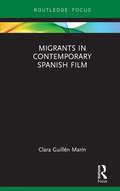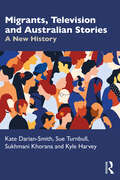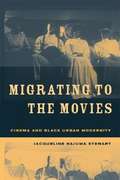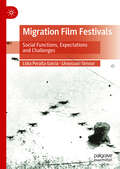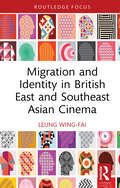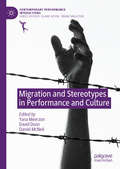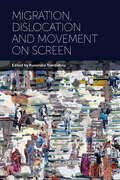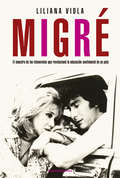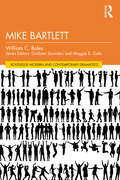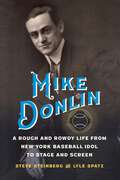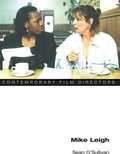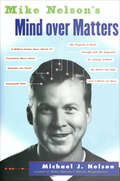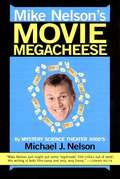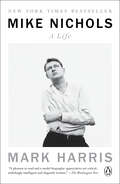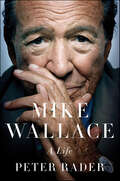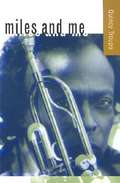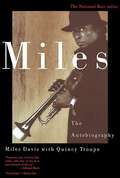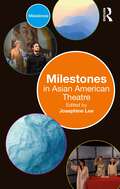- Table View
- List View
Midnight Cowboy (Queer Film Classics)
by Jon TowlsonMidnight Cowboy – the story of a small-town stud’s attempt to make it big as a hustler on the streets of 1960s New York – is an indisputably iconic film. Though recognized in terms of its early adoption of Nouvelle Vague cinematography and editing techniques, and renowned for an Oscar win in spite of controversy over its X-rating, Midnight Cowboy has yet to be understood as a classic of queer cinema.Jon Towlson reclaims Midnight Cowboy as a queer text by addressing John Schlesinger as a gay author and filmmaker and providing a fresh perspective on the film’s relationship to the 1965 James Leo Herlihy novel from which it was adapted. Offering a nuanced and personal view of the film’s relevance to queer experience and queer friendship, Towlson also considers Midnight Cowboy’s production and reception and its place in Schlesinger’s filmography. Depictions of sixties New York counterculture and 42nd Street hustlers offer an opportunity for reassessment, particularly in the film's relationship to male prostitution, male relationships, and sexual identity.By shifting the perspective away from previous interpretations of Midnight Cowboy as homophobic and problematic, Towlson argues for a new interpretation of the film as a proto-queer buddy movie and a critical forerunner to films such as My Own Private Idaho and Brokeback Mountain.
Midnight Justice (Spider-Man Super Thriller #1)
by Martin DelrioFIRST IN AN ALL-NEW SERIES! VENOM'S REVENGE! Spider-Man faces the fight of his life when the nightmare creature known as Venom targets both the web-slinger and his alter-ego, Peter Parker, for destruction! The deadly alien symbiote and its human host, Eddie Brock, collectively known as Venom, harbor a growing hatred for Spider-Man that violently explodes when Parker and Spider-Man are credited with helping clean up crime in the subways. But these tunnels are the domain of Venom, and the cleanup is his doing. The credit should rightly go to him! Venom challenges Spider-Man to a deadly midnightshowdown, at Manhattan's criminal-court building, in the middle of the worst snowstorm of the century. It's a brutal no-holds-barred contest, in which all the advantages seem to lie with Venom. Spider-Man must bag the crazed villain, or go down in the attempt!
Midnight Movies
by J. Hoberman Jonathan RosenbaumMidnight Movies is a comprehensive and in-depth look at over 100 subculture movies of the past three decades. It discusses the complete history of cult films, their makers, and their audience and what keeps audiences coming back to see them over and over again.
Midnight's Children (dramatization)
by Salman Rushdie Simon Reade Tim SuppleMidnight's Children tells three main tales: the turbulent history of twentieth-century India, Pakistan and Bangladesh; the saga of a Muslim family; and the story of one man, Saleem Sinai. This is a play based on the book.
Might as Well Laugh About it Now
by Marie Osmond Marcia WilkieThe beloved superstar reveals her thoughts on her milestones and missteps, career pressures and expectations, her popular line of collectible dolls, marriage and divorce, depression, weight issues, and the incredible joys and challenges in being a working mother raising eight children. <P><P>Marie's resilience and familiar humor will have every reader feeling at home with this international icon as she imparts her insights on surviving the school of life and graduating with a degree in unstoppable optimism.
Migrant Anxieties: Italian Cinema in a Transnational Frame (New Directions in National Cinemas)
by Áine O'HealyDuring a period of heightened global concerns about the movement of immigrants and refugees across borders, Migrant Anxieties explores how filmmakers in Italy have probed the tensions accompanying the country’s shift from an emigrant nation to a destination point for over five million immigrants over the course of three decades. Áine O’Healy traces a phenomenology of anxiety that is not only present at the sociopolitical level but also interwoven into the narrative strategies of over 30 films produced since 1990, throwing into sharp relief the interface between the local and the global in this transnational era. Starting with the representation of post-communist migrations to Italy from Eastern Europe and subsequent arrivals from Africa through the controversial frontier of Lampedusa, O’Healy explores topics as diverse as the configuration of migrant labor, affective surrogacy, Italian whiteness, and the legacy of Italy’s colonial history. Showing how contemporary filmmaking practices in Italy are linked to changes in the broader media landscape, O’Healy analyzes the ways in which both Italian and migrant filmmakers are reimagining Italian society and remapping the nation’s borderscape.
Migrant and Tourist Encounters: The Ethics of Im/mobility in 21st Century Dominican and Cuban Cultures (Routledge Interdisciplinary Perspectives on Literature)
by Andrea Easley MorrisMigrant and Tourist Encounters: The Ethics of Im/mobility in 21st Century Dominican and Cuban Cultures analyzes the effects of clashing flows of voluntary and involuntary travelers to and from these countries due to an increase in migration and tourism during the last three decades. I compare the ways in which literary works and films reflect on and critique the power relations and ethics of im/mobility and encounter, both on the islands and in destinations abroad. The works draw attention to the interconnectedness of migration, tourism, and other forms of travel as well as immobility, and portray growing local and global inequalities through characters’ disparate access to free, voluntary movement. I consider how the works respond to the question of the moral potential of encounters produced by im/mobilities and the possibility of connection across differences. I argue that Dominican and Cuban artists not only critique neo-colonial paradigms of power and im/mobility, but envision and enact strategies for belonging and, in some cases, suggest a path toward de-colonial cosmopolitanism.
Migrants in Contemporary Spanish Film (Routledge Focus on Film Studies)
by Clara Guillén MarínDuring the last two decades Spain has undergone an unprecedented transformation from being a country of emigrants to receiving a significant number of migrants from all around the world. This book focuses on the analysis of documentaries and fiction films representing migrants in Spain in the first decade of the twenty-first century. Guillén Marín explores the ways in which migrant and non-migrant filmmakers reframe the urban and rural space to create opportunities for a free, although contested, exchange between marginal voices and mainstream Spanish society. She analyzes the extent to which the films challenge forms of exclusion and represent ethnicity in a space that includes some and excludes others.
Migrants, Television and Australian Stories: A New History
by Kyle Harvey Sue Turnbull Sukhmani Khorana Kate Darian-SmithThis book examines the intertwined histories of television and migration in Australia, told from the perspectives of migrants who worked in the screen industry and the many more who watched television. Their stories demonstrate how Australia’s growing cultural diversity has challenged conventional representations of ‘Australianness’ on television, and how ongoing advocacy has supported the growing inclusivity of multiple narratives and diverse experiences on screen.Migrants from many backgrounds were instrumental in the establishment in 1956 of Australian television, working behind and in front of the cameras as producers, directors, writers, technicians and actors. From early broadcasting to the digital present, portrayals of cultural differences have often been shaped by appropriation, ethnic stereotyping and racism. This has occurred across a range of formats from drama to comedy to news and reality shows. Many in the industry have responded with resilience and creative adaptation, as they have increasingly taken control of the ways that migrant stories are told and diversity is celebrated.The first comprehensive Australian study of migrants and television, this book considers the ways multicultural audiences have experienced the small screen over seven decades. Drawing on rich oral histories, it analyses the memories of television in the work, school, family life and leisure of migrant communities and their broader engagements with Australian culture. Research in the archives of broadcasters and production companies reveals how non-Anglo Australian characters were constructed, and how such portrayals have shifted. This new history takes us to digital screen production and consumption today, exploring how Australians of many diasporas engage with the global network of screen content in the twenty-first century. It is essential reading for media professionals, advocates, students and those interested in the intersections between media, cultural diversity and the nation.
Migrating to the Movies: Cinema and Black Urban Modernity
by Jacqueline Najuma StewartThe first comprehensive book on African Americans and early cinema, which takes Chicago and the Great Migration as its primary case study.
Migration Film Festivals: Social Functions, Expectations and Challenges (Framing Film Festivals)
by Lidia Peralta García Lhoussain SimourThis book explores the intersections of migration and film festivals, with particular attention to their social functions . Adopting an interdisciplinary and multi-bottom line perspective, the authors address the purposes and circumstances of migration film festivals; their delimitation as distinct from other genres of festivals; their cinematographic creation; and their approaches to the curation and programming of films. Numerous questions arise in the process: Is social function prone to homogenization among migration film festivals? What are these festivals’ main constraints in negotiating their social functions? What is their actual capacity to foster social transformation? How do we conceive of the fact that most migration festival goers are rarely the ones in need of changing their perceptions? How are migrants actually involved in these cultural events? What are the specific challenges that undermine migration film festivals in achieving a greater social impact, and in turning into true axes of critical reflection towards more empathetic, inclusive and respectful ways of life?
Migration and Identity in British East and Southeast Asian Cinema (Routledge Focus on Film Studies)
by Wing-Fai LeungAn emerging interest in a British East and Southeast Asian identity after decades of political and social exclusion has coincided with periods of economic and political challenges in the UK. In Migration and Identity in British East and Southeast Asian Cinema, Leung Wing-Fai argues that this explosive context has created rich and diverse forms of storytelling and an accented cinematic language. By offering close readings of key contemporary films and positioning them in a wider slate of releases by British East and Southeast Asian filmmakers alongside Anglophone film histories in the Global North, this book sheds light on a developing field and engenders new ways of understanding British cinema and society. The author explores changing representational politics in contemporary cinema and argues for the cinematic visibility of a hitherto silenced community. Drawing on theoretical frames from sociological, film and cultural studies to critically engage with the textual and visual language of the case studies, Leung claims the place of British East and Southeast Asian Cinema as a film and cultural movement. Highlighting diversity among the British East and Southeast Asian community, pushing boundaries in its intersectional approach to ethnicity, race, gender and sexuality, and proposing a critical framework for academic studies on diasporic film-making in the UK, this nuanced and innovative study will interest researchers, teachers and students in a range of Humanities and Liberal Arts subjects, including Film and Media Studies, Regional/Area Studies (Asia), and arts, cultural and creative productions from the East and Southeast Asian diaspora.
Migration and Stereotypes in Performance and Culture (Contemporary Performance InterActions)
by David Dean Yana Meerzon Daniel McNeilThis book is an interdisciplinary collection of essays that delves beneath the media headlines about the “migration crisis”, Brexit, Trump and similar events and spectacles that have been linked to the intensification and proliferation of stereotypes about migrants since 2015. Topics include the representations of migration and stereotypes in citizenship ceremonies and culinary traditions, law and literature, and public history and performance. Bringing together academics in the arts, humanities and social sciences, as well as artists and theatre practitioners, the collection equips readers with new methodologies, keywords and collaborative research tools to support critical inquiry and public-facing research in fields such as Theatre and Performance Studies, Cultural and Migration Studies, and Applied Theatre and History.
Migration, Dislocation and Movement on Screen
by Ruxandra TrandafoiuContemporary screen industries such as film and television have become primary sites for visualizing borders, migration, maps, and travel as processes of separation and dislocation, but also connection. Migration, Dislocation and Movement on Screen pulls case studies in film and television industries from throughout Europe, North Africa, and Asia to interrogate the nature of movement via moving images. By combining theoretical, interdisciplinary engagements with empirical research, this volume offers a new way to look at screen media's representations of our contemporary world's transnational and cosmopolitan imaginaries.
Migré: El maestro de las telenovelas que revolucionó la educación sentimental de un país
by Liliana ViolaBiografía del creador de telenovelas célebres como Rolando Rivas, taxista, Piel naranja, Pobre diabla y Una voz en el teléfono, que moldearon la historia sentimental de generaciones de argentinos. Lo llamaron "el señor éxito", "el padre de la lágrima" y "el autor del amor". Escribió más de 700 títulos sin más colaboradores que su máquina Remington. Sus telenovelas fueron una verdadera factoría de galanes, parejas románticas y canciones inolvidables. Durante cuatro décadas tuvo en sus manos las emociones domésticas de las tardes y las noches. Con Rolando Rivas taxista, la ficción más recordada de la televisión argentina, conquistó al público masculino y marcó un nuevo estándar en el modo de producir y mirar tv. Se atrevió a plantear un final infeliz en Piel Naranja en vísperas de la dictadura de 1976 e impuso una palabra guaraní -"rojaiju"- en el lenguaje amoroso de los años 70'. Ultimo representante de la telenovela de autor, Alberto Migré sentó las bases de una industria de los sentimientos que se volvió global. En este libro apasionante Liliana Viola construye una biografía a la medida de su personaje donde cada secreto revelado abre las puertas de un secreto mayor. Actores y actrices, directores, admiradores y amigos íntimos aportan testimonios desopilantes y conmovedores para el retrato del hombre que patentó un modo de amar alternativo a la vida real y supo denunciar como ninguno la influencia nefasta del machismo en las relaciones humanas y el factor melodrama en los rencores que signan la política argentina.
Mike Bartlett (Routledge Modern and Contemporary Dramatists)
by William C. BolesHailed as one of the most talented playwrights to have emerged in the late 2000s, Mike Bartlett's diverse range of plays strike at the heart of the various crises predominant in the early twenty-first century. Offering the first extensive examination of the plays and television series written by award winning playwright Mike Bartlett, this volume not only provides analysis of some of Bartlett’s best-known works (Cock, Doctor Foster, King Charles III, and Albion), but also includes new interviews with Bartlett and some of his closest and oft relied upon collaborators. In this book, Bartlett’s plays and television series are grouped together thematically, allowing the reader to observe the cross-pollination between his works on the stage and screen. The book also includes an introductory biographical chapter that discusses early influences on his writing (Harold Pinter, Mark Ravenhill, Tony Kushner, and Quentin Tarantino), his time in the Young Writers Programme at the Royal Court, and his work with the Apathists.Routledge Modern and Contemporary Dramatists is a series of innovative and exciting critical introductions to the work of internationally pioneering playwrights, giving undergraduate students an ideal point of entry into these key figures in modern drama.
Mike Donlin: A Rough and Rowdy Life from New York Baseball Idol to Stage and Screen
by Steve Steinberg Lyle SpatzMike Donlin was a brash, colorful, and complicated personality. He was the most popular athlete in New York and was a star on the powerful New York Giants teams of 1905 and 1908. Though haunted by tragedy, including the deaths of both of his parents as a boy, Donlin was a charming, engaging, and kind-hearted man who also had successful careers on the stage and in film. One of the early &“bad boys&” among professional athletes, Donlin&’s temper and combativeness—compounded by alcoholism—led to battles with umpires and fans, numerous suspensions from the game, and even jail time. In 1906, when Donlin married vaudeville actress Mabel Hite, his life changed for the better, and their love story captivated the nation. Donlin left baseball after his sensational comeback for the dramatic 1908 season and joined Mabel on the stage, likely losing a Hall of Fame career. Then in 1912, at the age of twenty-nine, Mabel died of intestinal cancer. After making a final comeback as a player in 1914, Donlin starred in baseball&’s first feature film. He became a drinking buddy of actors John Barrymore and Buster Keaton and married actress Rita Ross. The couple moved to Hollywood, where Donlin became a beloved figure and appeared in roughly one hundred movies, mostly in minor roles. Despite his Hollywood career, Donlin stayed connected to the game he loved and was seeking a coaching job with the Giants when he died of a heart attack in 1933. At the dawn of the celebrity era of sports, Donlin was one of the nation&’s first athletes to capture the public&’s attention. This biography by Steve Steinberg and Lyle Spatz shows why.
Mike Leigh (Contemporary Film Directors)
by Sean O'SullivanIn this much needed examination of Mike Leigh, Sean O'Sullivan reclaims the British director as a practicing theorist--a filmmaker deeply invested in cinema's formal, conceptual, and narrative dimensions. In contrast with Leigh's prevailing reputation as a straightforward crafter of social realist movies, O'Sullivan illuminates the visual tropes and storytelling investigations that position Leigh as an experimental filmmaker who uses the art and artifice of cinema to frame tales of the everyday and the extraordinary alike. O'Sullivan challenges the prevailing characterizations of Leigh's cinema by detailing the complicated constructions of his realism, positing his films not as transparent records of life but as aesthetic transformations of it. Concentrating on the most recent two decades of Leigh's career, the study examines how Naked, Secrets and Lies, Topsy-Turvy, Vera Drake, and other films engage narrative convergence and narrative diffusion, the tension between character and plot, the interplay of coincidence and design, cinema's relationship to other systems of representation, and the filmic rendering of the human figure. The book also spotlights such earlier, less-discussed works as Four Days in July and The Short and Curlies, illustrating the recurring visual and storytelling concerns of Leigh's cinema. With a detailed filmography, this volume also includes key selections from O'Sullivan's several interviews with Leigh.
Mike Nelson's Mind Over Matters
by Michael J. NelsonWhy do some people retain cute baby-talk names for their relatives (like "Num-Num" and "Pee-Paw") well into middle age? How should a reasonable person respond when Olivia Newton-John sings, "Have you never been mellow?" Who's responsible for the sorry state of men's fashion, and is it the same guy who invented the jerkin? Is there any future in being a Midwesterner? Can you really enjoy your lunch when the restaurant is decorated to look like an African plain? How come women keep dozens of bottles and jars of moisturizers, unguents, and lotions around -- all of them half empty? In more than 50 hilarious all-new essays, one of America's brightest young humorists -- the head writer and on-air host of the legendary TV series Mystery Science Theater 3000 -- finds the fun in all aspects of the human condition, no matter how absurd. Join Mike Nelson on an angst-filled visit to a health spa; shopping sessions at Home Depot and Radio Shack; adventures in the very amateur musical theater; a gut-busting discourse on the history of television; ruminations on his roles as husband, father, and citizen; and much, much more.
Mike Nelson's Movie Megacheese
by Michael J. NelsonYou might think that after ten seasons on the Peabody Award-winning TV series Mystery Science Theater 3000, Mike Nelson has seen enough bad movies for one lifetime. As the guys at Cahiers du Cinema say, au contraire! Hollywood's spigot of stupidity shows no sign of slowing, and cheesy films continue to flood our multiplexes and gunk up our home entertainment centers at an alarming rate. This dire situation calls for a specialist. A professional. An expert in wading through motion pictures so vile that they aren't released; they escape. We need Mike Nelson! Hey, settle down there, pal--you got him! In more than sixty laugh-out-loud reviews and essays featuring his unique combination of erudite wit and shameless clowning, this screenscarred veteran takes us deep into the recesses of cinematic cheese. He examines legendary showbiz families like Culkin, Baldwin, and Estevez; uncovers an ancient quatrain in which Nostradamus foretells the coming of David Hasselhoff; makes the case for the Food Network and the Three Stooges; and skewers all kinds of movies, including Lost in Space, Twister, Anaconda, The Postman, Spring Break, My Best Friend's Wedding, The Bridges of Madison County, The Blair Witch Project, and many, many more. Here is a film critic for the rest of us: the outrageous, hilarious Mike Nelson.
Mike Nichols: A Life
by Mark HarrisA magnificent biography of one of the most protean creative forces in American entertainment history, a life of dazzling highs and vertiginous plunges--some of the worst largely unknown until now--by the acclaimed author of Pictures at a Revolution and Five Came BackMike Nichols burst onto the scene as a wunderkind: while still in his twenties, he was half of a hit improv duo with Elaine May that was the talk of the country. Next he directed four consecutive hit plays, won back-to-back Tonys, ushered in a new era of Hollywood moviemaking with Who's Afraid of Virginia Woolf?, and followed it with The Graduate, which won him an Oscar and became the third-highest-grossing movie ever. At thirty-five, he lived in a three-story Central Park West penthouse, drove a Rolls-Royce, collected Arabian horses, and counted Jacqueline Kennedy, Elizabeth Taylor, Leonard Bernstein, and Richard Avedon as friends. <P><P>Where he arrived is even more astonishing given where he had begun: born Igor Peschkowsky to a Jewish couple in Berlin in 1931, he and his younger brother were sent to America on a ship in 1939. The young immigrant boy caught very few breaks. He was bullied and ostracized--an allergic reaction had rendered him permanently hairless--and his father died when he was just twelve, leaving his mother alone and overwhelmed. <P>The gulf between these two sets of facts explains a great deal about Nichols's transformation from lonely outsider to the center of more than one cultural universe--the acute powers of observation that first made him famous; the nourishment he drew from his creative partnerships, most enduringly with May; his unquenchable drive; his hunger for security and status; and the depressions and self-medications that brought him to terrible lows. It would take decades for him to come to grips with his demons. In an incomparable portrait that follows Nichols from Berlin to New York to Chicago to Hollywood, Mark Harris explores, with brilliantly vivid detail and insight, the life, work, struggle, and passion of an artist and man in constant motion. Among the 250 people Harris interviewed: Elaine May, Meryl Streep, Stephen Sondheim, Robert Redford, Glenn Close, Tom Hanks, Candice Bergen, Emma Thompson, Annette Bening, Natalie Portman, Julia Roberts, Lorne Michaels, and Gloria Steinem. <P>Mark Harris gives an intimate and evenhanded accounting of success and failure alike; the portrait is not always flattering, but its ultimate impact is to present the full story of one of the most richly interesting, complicated, and consequential figures the worlds of theater and motion pictures have ever seen. It is a triumph of the biographer's art. <P><P><b>A New York Times Bestseller</b>
Mike Wallace: A Life
by Peter RaderThe untold story of how the world's most feared TV reporter transformed his inner darkness into a journalistic juggernaut that riveted millions and redefined the landscape of television newsIn his four decades as the front man for 60 Minutes, the most successful show in television history, Mike Wallace earned the distinction of being hyperaggressive, self-assured, and unflinching in his riveting exposés of injustice and corruption. His unrivaled career includes interviews with every major newsmaker of the late twentieth century, from Martin Luther King to Mahmoud Ahmadinejad.Behind this intimidating facade, however, Wallace was profoundly depressed and haunted by demons that nearly drove him to suicide. Despite reaching the pinnacle of his profession, Wallace harbored deep insecurities about his credentials as a journalist. For half his life, he was more "TV Personality" than reporter, dabbling as a quiz show emcee, commercial pitchman, and actor. But in the wake of a life-changing personal tragedy, Wallace transformed himself, against all odds, into the most talked-about newsman in America.Peter Rader's Mike Wallace: A Life tells the story of a courageous man who triumphed over personal adversity and redefined the landscape of television news.
Miles and Me
by Quincy TroupeQuincy Troupe's candid account of his friendship with Miles Davis is a revealing portrait of a great musician and an intimate study of a unique relationship. It is also an engrossing chronicle of the author's own development, both artistic and personal. As Davis's collaborator on Miles: The Autobiography, Troupe--one of the major poets to emerge from the 1960s--had exceptional access to the musician. This memoir goes beyond the life portrayed in the autobiography to describe in detail the processes of Davis's spectacular creativity and the joys and difficulties his passionate, contradictory temperament posed to the men's friendship. It shows how Miles Davis, both as a black man and an artist, influenced not only Quincy Troupe but whole generations. Troupe has written that Miles Davis was "irascible, contemptuous, brutally honest, ill-tempered when things didn't go his way, complex, fair-minded, humble, kind and a son-of-a-bitch." The author's love and appreciation for Davis make him a keen, though not uncritical, observer. He captures and conveys the power of the musician's presence, the mesmerizing force of his personality, and the restless energy that lay at the root of his creativity. He also shows Davis's lighter side: cooking, prowling the streets of Manhattan, painting, riding his horse at his Malibu home. Troupe discusses Davis's musical output, situating his albums in the context of the times--both political and musical--out of which they emerged.
Miles: The Autobiography
by Quincy Troupe Miles DavisFor more than forty years Miles Davis has been in the front rank of American music. Universally acclaimed as a musical genius, Miles is one of the most important and influential musicians in the world. The subject of several biographies, now Miles speaks out himself about his extraordinary life. Miles: The Autobiography,like Miles himself, holds nothing back. For the first time Miles talks about his five-year silence. He speaks frankly and openly about his drug problem and how he overcame it. He condemns the racism he has encountered in the music business and in American society generally. And he discusses the women in his life. But above all, Miles talks about music and musicians, including the legends he has played with over the years: Bird, Dizzy, Monk, Trane, Mingus, and many others. The man who has given us some of the most exciting music of the past few decades has now given us a compelling and fascinating autobiography, featuring a concise discography and thirty-two pages of photographs.
Milestones in Asian American Theatre (Milestones)
by Josephine LeeThis introduction to Asian American theatre charts ten of the most pivotal moments in the history of the Asian diaspora in the USA and how those moments have been reflected in theatre. Designed for weekly use on Asian American theatre courses, ten chosen milestones move chronologically from the earliest contact between Japan and the West through the impact of the Vietnam War and the resurgent "yellow peril" hysteria of COVID-19. Each chapter emphasizes common questions of how racial identities and relationships are understood in everyday life as well as represented on the theatrical stage and in popular culture. Milestones are a range of accessible textbooks, breaking down the need-to-know moments in the social, cultural, political, and artistic development of foundational subject areas.
